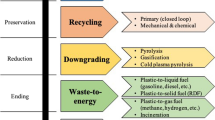Abstract
Plastic recycling has been the key issue for reducing environmental problems and resolving resource depletion. To improve the recovery rate of plastics, the plastic wastes are correctly identified according to their resin type. However, the identification system, which is able to identify black plastics according to not only the type of black plastics but also the grade of resins correctly, has not been introduced. In this paper, laser-induced breakdown spectroscopy, intelligent algorithms and preprocessing algorithms are used to improve the identification of black plastics such as polypropylene, polystyrene (PS), and acrylonitrile butadiene styrene (ABS). The laser-induced breakdown spectroscopy is capable of obtaining the characteristic spectrum regardless of material’s physical state. To extract the new features which are very valuable to improving learning performance, increasing computational efficiency, and building better generalization models from the obtained spectra through laser-induced breakdown spectroscopy, the hybrid preprocessing algorithm, composed of principal component analysis and independent component analysis, is used. In addition, the intelligent algorithm named the extended radial basis function neural networks inheriting the advantages of fuzzy theory and neural networks is used to identify black plastic samples into several categories with respect to their resins. The proposed identification system, composed of three parts such as laser induced breakdown spectroscopy, hybrid preprocessing algorithms, and an efficient intelligent classification algorithm, is able to show the synergy effect on the black plastic identification problem. From several experimental results, it can be seen that the identification system based on laser-induced breakdown spectroscopy and the intelligent algorithm is used for identification of black plastics by resin type.











Similar content being viewed by others
References
Saeed MO, Hassan MN, Mujeebu MA (2009) Assessment of municipal solid waste generation and recyclable materials potential in Kuala Lumpur. Malays Waste Manag 29(7):2209–2213
Liu C, Wu XW (2010) Factors influencing municipal solid waste generation in China: a multiple statistical analysis study. Waste Manag Res 29:371–378
Brunner S, Fomin P, Kargel Ch (2015) Automated sorting of polymer flakes: fluorescence labeling and development of a measurement system prototype. Waste Manag 38:49–60
Gundupalli SP, Hait S, Thakur A (2017) A review on automated sorting of source-separated municipal solid waste for recycling. Waste Manag 60:56–74
Niaounakis M (2013) Biopolymers: reuse, recycling, and disposal, Chap. 5. William Andrew, New York, NY, pp 151–163
Scott DM (1995) A two color near-infrared sensor for sorting recycled plastic waste. Meas Sci Technol 6:156–159
Edward J, Sommer JR (2001) Method and apparatus for near infrared sorting of recycled plastic waste. US Patent 2001/0045518. pp A1
Sattmann R, Monch I, Krause H, Noll R, Couris S, Hatziapostolou A, Mavromanolakis A, Fotakis C, Larrauri E, Miguel R (1998) Laser-induced breakdown spectroscopy for polymer identification. Appl Spectrosc 52:456–461
Cremers DA, Radziemski LJ (2013) Handbook of laser-induced breakdown spectroscopy. Wiley, New Jersey
Smith L (2002) A tutorial on principal components analysis. Cornell University, USA, pp 65
Yoo S-H, Oh S-K, Pedrycz W (2013) Design of face recognition algorithm using PCA-LDA combined for hybrid data preprocessing and polynomial-based RBF neural networks: design and its application. Expert Syst Appl 40(5):1451–1466
Bell AJ, Sejnowski TJ (1995) An information maximization approach to blind separation and blind deconvolution. Neural Comput 7:112–114
Gacek A, Pedrycz W (2015) Clustering granular data and their characterization with information granules of higher type. IEEE Trans On Fuzzy Syst 23(4):850–860
Tang XQ, Zhu P (2013) Hierarchical clustering problems and analysis of fuzzy proximity relation on granular space. IEEE Trans On Fuzzy Syst 21(5):814–824
Bouchon-Meunier B, (1992) Linguistic hedges and fuzzy logic, fuzzy systems, IEEE international conference. pp 241–254
Er MJ, Wu SQ, Lu JW, Toh HL (2002) Face recognition with radical basis function (RBF) neural networks. IEEE Trans Neural Netw 13(5):697–710
Jing XY, Yao YF, Zhang D, Yang JY, Li M (2007) Face and palm print pixel level fusion and kernel DCV-RBF classifier for small sample biometric recognition. Pattern Recogn 40:3209–3224
Chandra B, Naresh Babu KV (2014) Classification of gene expression data using spiking wavelet radial basis neural networks. Expert Syst Appl 41:1326–1330
Roh S-B, Oh S-K (2014) Polynomial fuzzy radial basis function neural networks classifier with the aid of boundary area decision. J Electr Eng Technol 9(6):2098–2106
MATLAB Toolbox Release (2016) The MathWorks, Inc., Natick, MA
Frank E, Hall MA, Witten IH (2016) The WEKA workbench. Online appendix for “data mining: practical machine learning tools and techniques, 4th edn. Morgan Kaufmann, Burlington, MA
Acknowledgements
This study was supported by the R&D Center for Valuable Recycling (Global-Top R&D Program) of the Ministry of Environment (Project no: 2016002250002).
Author information
Authors and Affiliations
Corresponding author
Rights and permissions
About this article
Cite this article
Roh, SB., Park, SB., Oh, SK. et al. Development of intelligent sorting system realized with the aid of laser-induced breakdown spectroscopy and hybrid preprocessing algorithm-based radial basis function neural networks for recycling black plastic wastes. J Mater Cycles Waste Manag 20, 1934–1949 (2018). https://doi.org/10.1007/s10163-018-0701-1
Received:
Accepted:
Published:
Issue Date:
DOI: https://doi.org/10.1007/s10163-018-0701-1




